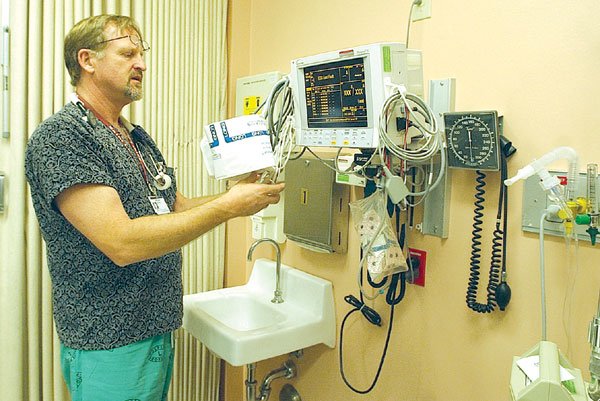GILROY
– Saint Louise Regional Hospital is a typical example of a
small, community hospital caught up in the debate surrounding an
effective treatment for heart attacks offered only at larger
hospitals.
By Lori Stuenkel
GILROY – Saint Louise Regional Hospital is a typical example of a small, community hospital caught up in the debate surrounding an effective treatment for heart attacks offered only at larger hospitals.
Angioplasty, a treatment for heart attacks that is overtaking the traditional procedure of giving clot-dissolving drugs to heart attack patients, is not offered at Saint Louise.
“The angioplasty has now pulled ahead, because our intervention is so good,” Saint Louise Cardiologist Cheung “Tom” K. Leung said. “If (a patient) comes in with a heart attack, we now know that if we go in and we open up (the coronary artery), they do better.”
Heart attack victims in Gilroy are still taken by ambulance to Saint Louise before they can be transferred to San Jose to receive the treatment.
“(The ambulance) always goes to the closest facility, just so they can get into an emergency room and get the best shot,” said Phil King, emergency medical services division chief for the Gilroy Fire Department. “Part of the problem, too, is that on-scene you don’t really know if the person needs an angioplasty. We just treat the chest pain; we don’t diagnose and know they’re having a heart attack.”
Emergency responders administer pain medication before the patient reaches the hospital. From the time a patient enters the hospital, it usually takes 30 minutes to do assessments and determine whether the patient should receive a clot dissolver or be transferred for an angioplasty, Leung said.
Numerous studies conducted in the past 20 years indicate that angioplasty is more effective than widely used clot-busting drugs, but only one in five hospitals is able to offer the procedure 24 hours a day. Angioplasty restores blood flow to the heart in 95 percent of cases whereas clot-dissolvers work about two-thirds of the time.
Angioplasty effectively can stop a heart attack, restoring blood flow to blood-deprived heart tissue, reducing the need for medication and relieving chest pain.
It is considered a minor surgery, usually requiring only local anesthesia. A cardiologist punctures the femoral artery in the groin to insert a catheter with a small balloon attached. The catheter is directed up to the site of the blockage and the balloon is inflated, opening the artery and allowing blood to flow to the heart. The patient is awake during the procedure.
There are some complications associated with angioplasty, but most are minor.
“The sicker the patient, the more benefit they have,” Leung said.
Complications include bleeding or infection at the catheter insertion site, ruptured artery, kidney failure or a torn vessel wall.
A patient also can be spared from undergoing bypass surgery, in which a surgeon borrows a blood vessel from another part of the body, usually the leg, to repair a blocked coronary artery. Bypass surgery requires cutting through the chest bone to operate on the heart and a recovery period of several months.
Saint Louise cannot offer the procedure because it must be performed in a cardiac catheterization laboratory, which the hospital does not have and will not have in the foreseeable future.
“In order to do a lot of cardio services, you need a significant population base. Otherwise, it’s not feasible to do it in a small community,” said James Roosevelt, executive director and chief executive officer of the Saint Louise Regional Hospital Foundation. “We just don’t have the capacity to do that.”
Building and staffing the labs is too expensive for smaller hospitals to offer the procedure, Roosevelt said, and once a hospital has the facilities, angioplasty teams must be able to hone their skills on a steady flow of cases.
The crux of the matter is whether heart attack victims should be taken directly to a facility that offers angioplasty or given an injection of a clot dissolver at the nearest hospital.
“If they’re in shock, a big heart attack, those should be going,” Leung said. “Not all must go, but the high-risk should go. You could make a case to make everybody go, but because many hospitals still don’t have cath lab, it’s just not feasible.”
O’Connor Hospital, Saint Louise’s sister hospital in San Jose, is the closest hospital that offers angioplasty.
In some areas, heart attack victims are automatically taken to a larger hospital that can perform the procedure, but doctors debate whether it is as effective if too much time passes.
“It’s more prudent to get (a patient) to an emergency room than to assume they need an angioplasty,” King said.
Saint Louise will not have the capacity in the near future to open a cardiac catheterization laboratory and stock it with the necessary state-of-the-art equipment, such as real-time X-ray machines. To house such a lab would require a minimum $10 million investment, Roosevelt said.
Still, Leung said, the hospital is ready to begin eying the procedure.
“It would take investment, but we should do it,” Leung said. “This should be part of the thinking when we expand. … It probably will not be at every hospital, but I think Gilroy is ready with the role that we have.”














